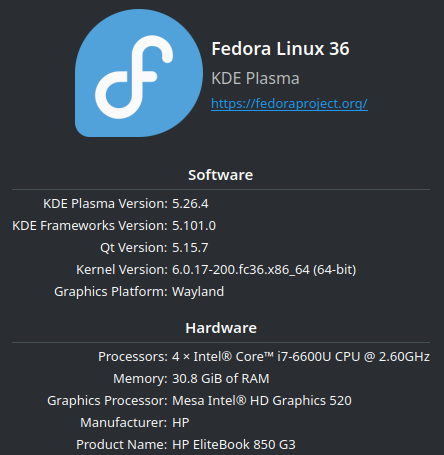Almost half a year into the Great Linux Experiment and I’m still here.

The last time I tired running Linux as a desktop OS was back around 2001. It went so horribly sideways that I lasted maybe two days. Then again this was 2001 and while I could get Linux (Mandrake) installed, couldn’t get the damned thing online. So it was essentially a weekend of yelling and screaming to myself because I had no Internet to yell and scream into.
Now I can scream all I want, anytime I want. Here are a few things I’ve discovered:
I prefer KDE over Gnome. I find Gnome garish and sluggish and it comes off as a half baked macOS clone. KDE is Windows-ish, but not enough to make me raise an eyebrow. I also find it much more responsive than Gnome.
I installed Plex. Holy Christ on a crutch it’s awesome. One of my concerns moving as far away from Apple as possible was our AppleTV. I’ve gotten used to downloading videos, sticking them in the TV app on my Mac and having them stream to the AppleTV in our living room.
There are two things that suck with Apple and videos that you’re not buying from them:
-
-
- Apple only allows MP4. So I’d have to run whatever I wanted to watch through something like Wondershare UniConverter 1. Sometimes even if it was already in MP4 format. Apple seems to like a super specific form of MP4, but they’re not telling anyone what that is…
- The Computers section on the AppleTV loads videos so slow that half the time I’d wonder if the Mac serving the content had dropped off the Internet or crashed.
-
Besides moving all of my day-to-day over to Linux, the ageing Mac mini that lived under my desk for the sole purpose of acting as a media server to the AppleTV, up and died.
It was time to try something else. Some quick research told me that Plex can handle pretty much any video format you throw at is and there is a Plex app for the AppleTV. Good enough for me.
Guess what? It all works flawlessly. I don’t have to convert videos, I can just throw them into my designated directory and it shows up in the Plex library and plays on our TV without issues. Also, the GUI in the app is heads and tails above whatever the glue sniffers at Apple have come up with for their “Computers” app on the ATV.
Added bonus: Plex is installed on pretty much every TV out there today so I don’t have to worry if the AppleTV takes a shit on us.)
From a music production standpoint, I’ve found a real gem in EQ10Q, an older set of LV2 plugins by a developer named Pere Ràfols Soler. I particularly like theEQ10Q equalizer itself and the CS10QM compressor. The plugins sound great and look great and I’ve used them pretty extensively on my current, in progress track.
From a straight up desktop standpoint, I’ve had zero issues. I’d go so far to say that for a good majority of people out there who just use their computers for checking email or social media, Linux would really be the way to go if they’re looking to save money. Yes, I’ve had a few minor problems which I’m going to outline below but, again, all computers have their own problems.
Speaking of which, let’s look at the issues I’ve worked through..
Read Every Message
This one is a doozy, and it was self inflicted.
A little over a month into this experiment, I added a secondary hard drive to the laptop and when configuring it, I think I somehow set it as the main drive. The computer booted fine, but when I got into the OS, it asked me something about a “main drive” and I stupidly didn’t read the message and clicked OK.
Everything seemed fine until I rebooted the computer after some security updates. It never made it past the HP logo, even after I removed the secondary drive. I had to flatten the main drive and reinstall Fedora.
It didn’t bother me to have to reinstall. I mean, I cut my teeth on Windows 95 through 7 where a reformat/reinstall every couple of months was pretty much required to keep your computer running smooth.
As an aside, having to reformat/install Fedora made me appreciate OneDrive, once again.
There is a lot to complain about when it comes to Microsoft, but their Microsoft 365 Personal 2 plan is amazing if only because of OneDrive and its 1TB of cloud storage.
The only minor problem I ran into in the beginning was that while the OneDrive app works seamlessly across Windows, Mac, iOS, and Android, there is no native Linux app.
Enter Insync which supports OneDrive and costs a one time payment of not so much. There is an optional yearly support plan if you want, but you’re not forced into it. I’ve been using Insync since the beginning of this experiment and I highly recommended it.
Reaper Go Boom
Reaper just does not play well with some plugins.
-
-
- ToneLib GFX: the plugin will only work on a single track. If you add it to a second, Reaper crashes. I have to employ a workaround to get ToneLib on multiple tracks.
- Reaper’s support LV2 plugins half baked. Sometimes they load, but any custom GUI is ignored ignored. Or they crash Reaper just as hard as ToneLib.
-
I’m still trying to figure out why; support for Reaper and ToneLib is limited to user forums where there is not a lot of Linux users and answers are mostly “well, it works for me” (if there are answers).
For reasons I won’t get into, I ended up mixing my recent song in Reaper and had to stick to the included Reaper plugins which is a little disappointing. I get that Reaper in Linux is pretty new and isn’t as shored up as the Windows or Mac version so I’ll just have to keep at it. It’s still great for laying down my basic tracks so it still has its place.
I’m still messing around with this, and I think this is a Reaper issue as the plugins I’ve installed work just fine in Mixbus.
As a note, I tried Ardour, but it crashed even if I so much as thought about adding a track or clicking on a menu. I think I’ll be sticking to Mixbus and Reaper (warts and all).
Tascam USB Minor Weirdness
I don’t know why, but sometimes my Tascam unit just drops. As of this writing, it’s picking up the mic inputs, but it’s being ignored as an output device. I noticed that this started happening after I spent a day trying to get Ardour working, and installed system and security updates. I’m sure I’ll get it figured out but it’s a wee bit frustrating at the moment.
Looks like it may have been the updates. The sudo dnf swap wireplumber pipewire-media-session command from this page seemed to fix it up. The sound is a little quieter than before, but it’s working.
Other Than That
I’ll keep saying it until the proverbial cows come home: I am still floored at how stable and fast Fedora Linux runs on six year old hardware 3. In an age where Microsoft is cutting off hardware support of it’s latest OS, and Apple is working on the lock-in even more by designing its own chipsets, it’s nice to have this option out there. Not only is it inexpensive, it allows you to make use of of the castaway, used, refurbished, left for dead computers out there. One computer saved from the landfill is not a huge thing, but it’s a damn good start.
1: Or Handbreak; but more often than not, the AppleTV just did not like whatever MP4 Handbreak spit out and I’d have to reconvert.
2: I am not linking to the MS Products page because I’m not being paid to shill for them, I just really think that plan beats out all other options when it comes to cloud storage on Linux. I pay $80 a year for a Personal Plan and if it only included OneDrive it would be worth it. Dropbox is $130 a year for 2TB. .Google is $140 for 2TB. Apple iCloud is $150 for 2TB …
Yes, that’s for 2TB, but I’d guess that the average person doesn’t fucking need 2TB. Why do all these cloud storage companies seem to think everyone needs 2TB of space? What the hell do they think we’re storing? 500GB should be fine for most, 1TB is a sweet spot that no one but Microsoft offers.
There are other cloud storage options, but they’re companies I’ve not heard of until now and they’re just as pricey. For instance, pCloud is $50/year for 500GB or $100/year for 2TB; just storage, no other features. Look at any of these. Sorry, but MS really has this nailed down.
3: It’s even little things. I mean, Apple has been bragging about how fast their laptops wake up from sleep. They tell us that this is because they design the hardware as well as the software, marketingspeak, blah-blah, wonk-wonk. Sure ok, MacBooks wake from sleep very fast and I like this about them. But if I close the lid on this old ass HP, it goes to sleep and when I open the lid my login screen pops up in a second or two and I’m running one of literally dozens of Linux distros on random ass hardware.
By comparison, my work machine is a high end Dell and under both Windows 10 and 11, I’ve never seen it take any less than 30 seconds to kick in after I open the lid. Sometimes I have to push the power button for it to wake up.
So don’t tell me this feature is exclusive to MacBooks; the Open Source nerds figured it out. I think Microsoft is just not that interested.
